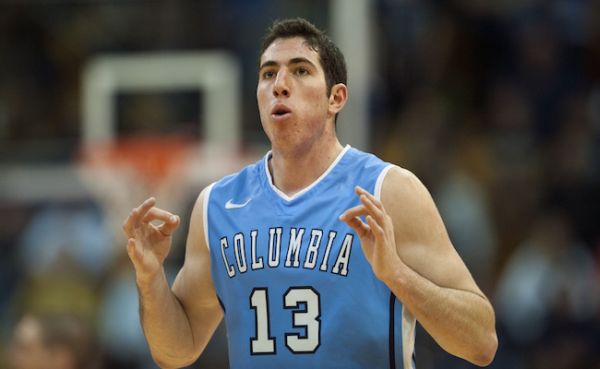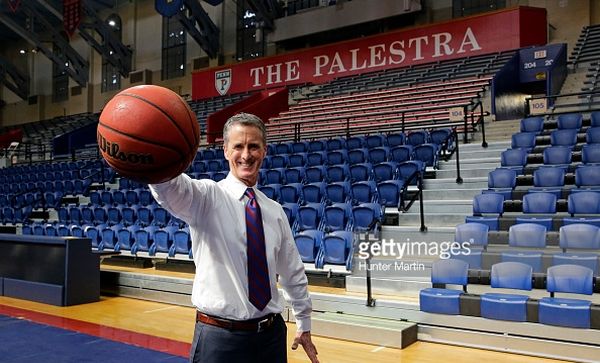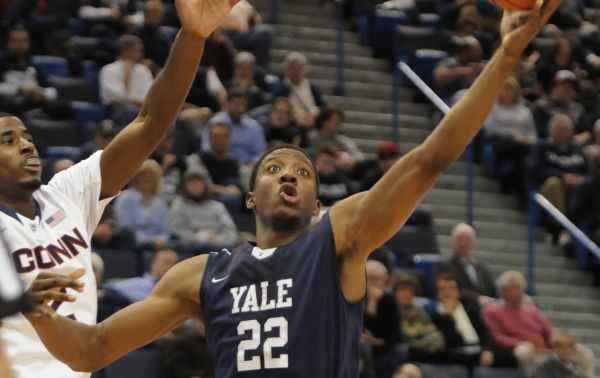Other 26 Previews: Ivy League
Posted by Michael James on November 10th, 2015Michael James is the RTC correspondent for the Ivy League. You can also find his musings on Twitter at @ivybball.
Reader’s Take
Top Storylines
- Unusual Suspects – The last time Harvard failed to receive a first-place vote in the preseason Ivy media poll, Cornell was wrapping up its three-peat in a season that would see the Big Red ultimately advance to the Sweet Sixteen. Five Ivy titles and four NCAA appearances later, the Crimson finds itself slotted fourth while the first-place votes were split as evenly as possible across the three favorites: Columbia, Princeton and Yale. Those three schools have combined for just one NCAA appearance over the last 11 seasons, and the Lions and Bulldogs haven’t made the Tournament since the 1960s. Yale arguably has the inside track after winning a share of the Ivy title last season, but Princeton returns all of its key contributors from a team that finished a strong third, and Columbia not only brings back a substantial portion of its squad but also adds former first-team All-Ivy forward Alex Rosenberg, who missed last year with a Jones fracture in his right foot.
- Donahue Returns — Recently, league teams have kept their coaching searches focused mostly on prior members of the Ivy family, and Penn didn’t deviate from that strategy this offseason, hiring former Cornell and Boston College coach Steve Donahue to replace Jerome Allen, who was fired after five-and-a-half years at the helm of the Quakers. Donahue got his first Division I coaching experience at Penn, serving as an assistant for 10 years and building strong ties in Philadelphia’s rich basketball landscape. Donahue will have his work cut out for him, though. After dominating the league for over 30 years, Penn has finished at least five games back of first in seven of the last eight seasons. For that reason, Donahue has embraced some outside-the-box thinking, including marshalling campus resources to build an analytics team to try to provide the Quakers an edge on the court.
- See You Next Year — With a surging set of experienced contenders in Columbia, Princeton and Yale, Harvard might finally be facing too tough a challenge to continue its streak of Ivy titles. Even if it takes a step back this year, though, reinforcements are on the way in an unprecedented fashion. The Crimson has received commitments from, depending on the recruiting outlet, as many as four four-star recruits in the 2016 class (forwards Chris Lewis and Robert Baker, swingman Seth Towns and point guard Bryce Aiken) and its seven-man incoming cohort currently ranks #8 nationally at ESPN.com.
- The Ivy Grad Transfer Team –– The Ivy League rules against explicit redshirting and graduate students playing on its teams has led to an increase wave of former Ivy hoopers moving on to high-profile programs. Shonn Miller left Cornell for the chance to play at UConn; Brown’s Rafael Maia chose to play his final season at Pitt; and Dartmouth guard Alex Mitola sped up his graduation to be eligible to transfer to George Washington. Rounding out the Ivy Grad Transfer squad are Princeton forward Denton Koon (Hofstra) and Cornell guard Galal Cancer (Kent State).
Predicted Order of Finish
- Princeton (11-3)
- Yale (11-3)
- Columbia (11-3)
- Harvard (7-7)
- Brown (5-9)
- Dartmouth (5-9)
- Penn (4-10)
- Cornell (2-12)
All-Conference First Team/Newcomer Prediction
- Maodo Lo, G, Columbia – Arguably the Ivy League’s best NBA Draft prospect, the Berlin native Lo spent his summer playing with current NBA stars Dirk Nowitzki and Dennis Schroder on the German National Team. Don’t be fooled by a drop in his raw numbers this season, though. The 6’3″ combo guard posted a 29 percent usage rate while playing 86 percent of team minutes in conference play last year, so it might be hard for Lo to match his counting stats from a year ago with Columbia adding some offensive firepower back to its roster, but he should be even more efficient than in the past.
- “Hold For Princeton Guard”, G, Princeton – The Tigers have an embarrassment of riches in their backcourt with as many as four returning candidates for an All-Ivy slot. Steven Cook and Spencer Weisz are the most likely options, having each nabbed Second Team honors last year. Amir Bell’s rookie season turned a lot of heads and nearly netted him Ivy Rookie of the Year honors. Finally, Henry Caruso didn’t have the same aggregate numbers as the other three, but his advanced metrics in Ivy play were worthy of all-league consideration, as he posted a 122 offensive rating on a 22 percent usage rate and 62 percent effective shooting.
- Justin Sears, F, Yale – The reigning Ivy Player of the Year has kind of flown under the radar, as Lo’s big summer has stolen the headlines. He’ll be easy to spot once the season gets underway — probably at the free throw line, as he’s posted a free throw rate in the 80s in conference games over the last two seasons. It’s also worth noting that Sears’ three best offensive performances in Ivy play last year came at the expense of co-favorites Columbia and Princeton.
- Alex Rosenberg, F, Columbia – It’s hard to be sure exactly how effective a player will be coming back from such a compromising injury as a Jones fracture, but Rosenberg’s decision to give it the necessary time to heal fully should increase the odds of him getting back to his former self. The 6’7 forward is a career 37 percent shooter from three and averaged over 10 free throw attempts per game in Ivy play in 2014 making him a multi-dimensional threat on the offensive end.
- Zena Edosomwan, C, Harvard – Harvard had six players to post a usage rate of 16 percent or higher last season. Four graduated and one (Siyani Chambers) has a torn ACL. That leaves Edosomwan, who has averaged a little over one shot per every three minutes on the floor during his two seasons in Cambridge thus far (not even counting earned trips to the line). He’s an incredibly difficult matchup one-on-one, but can be quick to force things in traffic. Regardless, given the number of minutes he’s likely to get and number of shots he’s likely to take, the counting stats will have him in competition for First Team honors.
Impact Newcomers
The Ivy Rookie of the Year race will be as crowded as ever this season with several teams outside the top three landing their most talented newcomers in precisely the position of greatest need. Here is a quick rundown of the many players who have a good shot at being in the ROY discussion in March:
- Jake Silpe, PG, Penn – With the announcement that Tony Hicks would forego his final season of eligibility at Penn to play as a graduate transfer elsewhere, this is now Silpe’s team. The 6’2″ freshman out of Cherry Hill, New Jersey has many Quakers fans drawing comparisons to another New Jersey product — Zack Rosen.
- Tommy McCarthy, PG, Harvard – Just as Silpe suddenly found himself with the keys to the offense, so to does McCarthy, as Chambers’ ACL injury opening up a gaping hole at point for Harvard. The Crimson has struggled to find point guard depth since Chambers arrived on campus, meaning that McCarthy will have a long leash to sink or swim this season.
- Corey Johnson, SG, Harvard – It’s hard to think of too many prospects who have used the junior national team competitions to increase their profile more than Johnson. The 2014 summer circuit vaulted Johnson from a fringe D-I prospect to one with offers from a bevy of mid-majors and even some multi-bid leagues. Coming off his hot shooting performance at the 2015 U19 World Championships, Johnson has caught the eye of NBA scouts for his highly coveted three-and-D skill set.
- Evan Boudreaux, PF, Dartmouth – Arguably the league’s highest rated recruit in the 2015 class, Boudreaux has huge shoes to fill with the graduation of Gabas Maldunas. Historically quiet on the recruiting trail, the Big Green boast the reigning Ivy Rookie of the Year in Miles Wright and have a great shot at repeating with Boudreaux.
- Stone Gettings, PF, Cornell – With Shonn Miller deciding to use his final season of eligibility in Storrs as a graduate transfer rather than returning for a fifth year at Cornell, the Big Red doesn’t return any interior players with a demonstrated ability to use even a relatively low number of possessions with decent efficiency. Gettings is Cornell’s best hope for interior production from the freshman class, so he’ll likely get every chance possible to demonstrate his worth.
- Travis Fuller, PF, Brown – Much like Cornell, Brown has to cope with a huge interior loss, as Rafael Maia moved on to Pittsburgh as a graduate transfer. The Bears have a great interior defender in Cedric Kuakumensah and a bevy of floor spacing shooters on the perimeter. Finding a credible forward to pair with Kuakumensah will be a challenge, however, and the freshman Fuller should be given a shot to fill that role.
Predicted Champion
- Princeton (NCAA Seed #12) — Between four years of Harvard and three years of Cornell, the only other Ivy team in the last eight seasons to represent the league in the NCAA Tournament was Princeton. You’ll hear a lot about what the Tigers aren’t. They aren’t the league’s most well-rounded team on both ends of the court (that would be Yale). They don’t have the most offensive firepower (that would be Columbia). The Ivy race will likely come down to a couple key games, though, and Princeton has two huge things going for it there: incredible balance offensively means that random issues like foul trouble are less likely to swing a result; and Jadwin gym has historically been worth a massive home court advantage boost due to its crazy sightlines.
Top Contenders:
- Yale (NIT/CBI/CIT): Between this past March 6th and March 15th, it’s hard to argue that any team had a greater rollercoaster of emotions than the Bulldogs. After a huge win over rival Harvard handed Yale control over its own destiny, the program sat on the precipice of something that hadn’t been done in over 50 years. Then a stunning collapse at Dartmouth and a last-second defeat to the Crimson in the Ivy playoff erased its NCAA hopes. Finally, the next night, the Bulldogs were kept out of the NIT and had missed out on a chance to play in the CBI or CIT as well, causing a once promising season to end by merely fading into the abyss. Yale assuredly remembers all of that and will use it as fuel to pursue those same dreams this season. The loss of some strong two-way players, though, raises questions of whether Yale can find replacements without having to sacrifice some of its offensive and defensive balance.
- Columbia (NIT/CBI/CIT): Cornell’s 2010 squad set the gold standard for offensive efficiency in the modern era, but this Columbia squad could come closer to that mark than almost any other team could. The question is whether the Lions can play any defense at all. Columbia was dead last in the league in defensive efficiency last year and haven’t finished an Ivy League Round Robin in the top half in that metric since Kyle Smith took over prior to the 2010-11 season. No team has won an Ivy title in the Pomeroy era without being essentially tied for second or better in defensive efficiency in league play.
- Harvard (CIT/CBI): The Crimson are included here for legacy purposes, but any real shot Harvard had evaporated when Chambers tore his ACL. The bigger question than the Ivy title is whether the Crimson can do well enough against an incredibly challenging schedule to get postseason eligible.
Reader’s Take II
Quo Vadimus?
“Can the Ivy League Get Its Game Back?” That was the question posed by The Wall Street Journal’s Darren Everson in May 2009. The piece went on to identify the Ivy League as “at a crossroads” with former Executive Director Jeff Orleans wrapping up his 25-year stint at the helm of the league, paving the way for Robin Harris to claim the role. Though the article focused on all sports, it applied most to basketball, as the traditional powers Penn and Princeton had tumbled to the bottom 100 of Division I, the league had just finished fifth-worst in Pomeroy and no Ivy school had won an NCAA Tournament game in 11 years.
Fast forward to today, and the piece has — to put it kindly — aged poorly, both in terms of basketball and Ivy sports in general. Harvard and Cornell combined to win four NCAA games since and both spent time in the Top 25, while Ivy football has hosted ESPN’s College Gameday and Yale won a national title in hockey.
In light of that, it might seem silly to title this section “Where are we going?” but it is the burning question derived from the league’s drastic turnaround since Harris took over six years ago. While she inherited an exogenous explosion of need-based financial aid that had, as a side-effect, a pronounced impact on the competitiveness of the no-scholarship Ivy League in the recruiting market, she is directly responsible for the other major factor in the rapid ascension of the league’s quality in all sports: The Ivy League Digital Network. Entering just its third full season, ILDN broadcasted over 1,100 live games in 2014-15 and is now in the final year of its original deal with NeuLion. The ability to see all league games with one package revolutionized what used to be a patchwork system of different platforms and broadcast standards provided by different schools.
The partnership and the league’s media strategy in general hasn’t been without its hiccups, however. Harvard, which hired the league’s first director of multimedia production, has been very aggressive in trying to distribute content across various platforms. In 2014, it had initially announced a partnership with ESPN3 to show a handful of conference games on that platform only to run afoul of the league’s NeuLion agreement which limits the number of such handoffs. That ESPN3 provides a Smart TV app option for direct streaming to televisions, which ILDN does not possess, made the inability to utilize that platform freely even more punitive. Also, the league has stoked the ire of its fans by having several high-leverage games, including last year’s playoff, end up on the syndicated American Sports Network, which relies on a patchwork network of regional channels to carry content.
The league’s desire to take the next step with a new, broader deal have been reported in outlets such as the Sports Business Journal. The Ivy office has also taken interim steps to demonstrate its understanding of the need to rethink its media strategy – most notably in securing Fox Sports 1 to broadcast an “if necessary” playoff game on the crowded Saturday of Championship Week. Balancing the supply side issues of schools with varying desires in terms of the financial and institutional commitment to the production and distribution of content and the demand side issues of a consumer looking to access it through a variety of different media will require a deft touch from Harris and her staff – a balance which she has been able to maintain admirably throughout her tenure thus far.
Final Thoughts
Over the past five seasons, Harvard, Princeton and Yale have finished in the top four every single year and have been joined by four different Ivy schools over that span. This season, the clear-cut favorite to be the “other” school is Columbia, but what isn’t so clear is whether Harvard will be able to lock down the fourth-place spot to keep the incredible streak alive.
Helping drive the wedge between the top three and the schools competing for fourth has been the key personnel losses on the part of the teams in the chase pack. Harvard lost Chambers – its senior leader and point guard. Brown transfer Blake Wilkinson started his career at Utah and could have been an immediate answer at the forward spot but will miss the year with an injury. Penn lost career 1,000-point scorer Tony Hicks just weeks before the season began. Dartmouth can relate, as it lost guard Alex Mitola — also a 1,000 point scorer — to George Washington as a grad transfer during the offseason. Finally, Cornell watched Shonn Miller — its best player from the post-Sweet 16 era — forego a potential fifth year to transfer to UConn.
Those losses have taken some of the teeth out of a league that had been growing in stature more by being tougher top to bottom than just being tougher at the top alone. Columbia, Princeton and Yale are strong enough with enough chances to record a fair number of wins over teams from multi-bid leagues. But unlike last year when the two teams tied for last each recorded surprising non-conference wins (Brown over Providence and Penn over Saint Joseph’s), the key personnel losses could limit the breadth of Ivy teams capable of securing notable scalps outside league play.
Ultimately, the race should come down to Columbia, Princeton and Yale and should be tight all the way. A third playoff in six seasons is entirely possible, and if it’s anything like last year’s scene at The Palestra, many Ivy fans might be rooting harder for that outcome than having any one team win it outright.














































C’mon man. Know your eligibility rules.
Miller couldn’t play at Cornell even if he tried this year.
Not allowed.